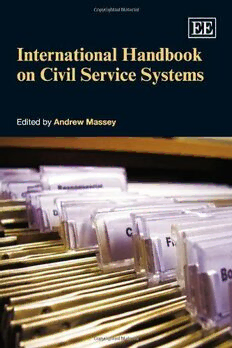
International Handbook on Civil Service Systems (Elgar Original Reference) PDF
392 Pages·2012·2.355 MB·English
Most books are stored in the elastic cloud where traffic is expensive. For this reason, we have a limit on daily download.
Preview International Handbook on Civil Service Systems (Elgar Original Reference)
Description:
While there is no universally accepted definition of civil servant and civil service, this authoritative and informative Handbook compares and contrasts various approaches to organizing the structure and activities of different civil service systems. The expert contributors consider the historical and theoretical context of public administration and public sector management, applying relevant theories and frameworks to provide a disciplinary perspective. Recurring topics and themes are explored, and international comparisons are made via case studies from Africa, Asia, Australasia, Europe, and North and South America. Issues addressed in each country study include accountability, structure, processes and institutions, as well as the relationship to the broader political systems in a world becoming aware that it exists within a differentiated polity. The Weberian legacy, joined-up government and the hollowed-out state thesis and the debate between Anglo-American influenced systems versus the Continental European approach to organizing the civil service are also discussed in detail. This systematic comparison of civil service systems and their political and theoretical foundations will prove essential reading for academics and students focusing on public policy and public sector management. Public service professionals will also find this book to be a crucial resource. Contributors include: T.E.D. Anagnosen, P. Barberis, E. Borgonovi, F. Buick, M. Desbouvries, M. Duggett, O.P. Dwivedi, M. Evans, A. Ferraro, J. Halligan, S. Horton, J.-M. Kauzya, M. Kikuchi, A. Massey, D.S. Mishra, A. Nakamura, J. O'Flynn, E. Ongaro, R. Parry, R. Pyper, C. Sadleir
See more
The list of books you might like
Most books are stored in the elastic cloud where traffic is expensive. For this reason, we have a limit on daily download.
